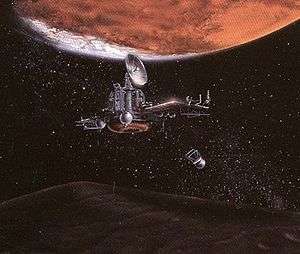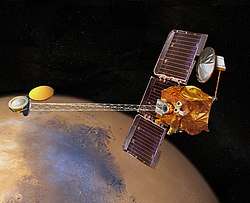Phobos 2
Phobos 2 was the last space probe designed by the Soviet Union. It was designed to explore the moons of Mars, Phobos and Deimos. It was launched on 12 July 1988, and entered orbit on 29 January 1989.

 Illustration of the Phobos spacecraft | |
| Mission type | Orbiter |
|---|---|
| Operator | Soviet Union |
| COSPAR ID | 1988-059A |
| SATCAT no. | 19287 |
| Website | www |
| Mission duration | 8 months, 15 days (launch to failure to reacquire transmissions) |
| Spacecraft properties | |
| Launch mass | 2600 kg (6220 kg with orbital insertion hardware attached)[1] |
| Start of mission | |
| Launch date | 17:01:43, 12 July 1988 (UTC) |
| Rocket | Proton-K rocket |
| End of mission | |
| Last contact | 27 March 1989 (spacecraft signal failed to be reacquired). |
| Orbital parameters | |
| Reference system | Areocentric |
| Mars orbiter | |
| Orbital insertion | 29 January 1989 |
Phobos 2 operated nominally throughout its cruise and Mars orbital insertion phases on 29 January 1989, gathering data on the Sun, interplanetary medium, Mars, and Phobos. Phobos 2 investigated Mars surface and atmosphere and returned 37 images of Phobos[2] with a resolution of up to 40 meters.
Shortly before the final phase of the mission, during which the spacecraft was to approach within 50 m of Phobos' surface and release two landers (One, a mobile hopper, the other, a stationary platform) contact with Phobos 2 was lost. The mission ended when the spacecraft signal failed to be successfully reacquired on 27 March 1989. The cause of the failure was determined to be a malfunction of the on-board computer.[2]
Background
The intent to carry out a mission with Phobos as the target was first made public 14 November 1984.[3] Phobos was chosen as the target after in order to avoid directly competing with previous American missions.[3] Originally a 1986 launch was planned but this latter moved to 1988.[3]
Mission profile
Phobos 2 started to develop problems during the interplanetary flight phase of the mission.[4] By the time the probe reached mars orbit two of its three computers were not working properly.[4] One of was completely dead and the second was starting to malfunction.[4] Since the probe worked on a system of its computers voting on any decision the one healthy computer would not be able to control the craft since it would be unable to outvote two dead computers.[4] The craft's high speed transmitter had also developed issues.[4]
Phobos 2 successfully carried out three preliminary encounters with Phobos during which time it was imaged with the Videospectrometric Camera, the Combined Radiometer and Photometer for Mars and the Imaging Spectrometer for Mars.[5]
Spacecraft Design
Instruments
The Phobos 2 infrared spectrometer (ISM) obtained 45000 spectra in the near infrared (from 0.75 to 3.2 μm) in the equatorial areas of Mars, with a spatial resolution ranging from 7 to 25 km, and 400 spectra of Phobos at 700 m resolution. These observations made it possible to retrieve the first mineralogical maps of the planet and its satellite, and to study the atmosphere of Mars. ISM was developed at IAS and DESPA (Paris Observatory) with support from CNES.
List of instruments:
- "VSK" TV imaging system
- PROP-F "hopping" lander.
- ARS-FP automatic X-ray fluorescence spectrometer
- ferroprobe magnetometer
- Kappameter magnetic permeability / susceptibility sensor
- gravimeter
- temperature sensors
- BISIN conductometer / tiltmeter
- mechanical sensors (penetrometer, UIU accelerometer, sensors on hopping mechanism)
- "DAS" (long-lived autonomous station) lander
- TV camera
- ALPHA-X Alpha-Proton-X-Ray Spectrometer
- LIBRATION sun sensor (also known as STENOPEE)
- Seismometer
- RAZREZ anchor penetrometer
- Celestial mechanics experiment
- "ISM" thermal infrared spectrometer/radiometer - 1±2 km resolution
- near-infrared imaging spectrometer
- thermal imaging camera; magnetometers
- gamma-ray spectrometers
- X-ray telescope
- radiation detectors
- radar and laser altimeters
- Lima-D laser experiment - designed to vaporize material from the Phobos surface for chemical analysis by a mass spectrometer
- Automatic Space Plasma Experiment with Rotating Analyzer (ASPERA), an electron spectrometer and ion mass analyser from the Swedish Institute of Space Physics.
Results
The craft took 37 photos of Phobos imaging the majority (80%) of the moon.[6] The infrared spectrometer found no sign of water.[6]
Legacy
The Phobos design was used again for the long delayed Mars 96 mission which ended in failure when the launch vehicle's fourth stage misfired. In addition, the Fobos-Grunt mission, also designed to explore Phobos, ended in failure in 2011. Thus far, there has not been a completely successful probe to Phobos.
References
- nasa.gov: Phobos Project Information
- Nature Publishing Group, Television observations of Phobos
- Harvey, Brian (2007). Russian Planetry Exploration History, Development, Legacy and Prospects. Springer-Praxis. p. 246. ISBN 9780387463438.
- Harvey, Brian (2007). Russian Planetry Exploration History, Development, Legacy and Prospects. Springer-Praxis. p. 253-254. ISBN 9780387463438.
- Murchiea, Scott; Erardb, Stephane (September 1996). "Spectral Properties and Heterogeneity of Phobos from Measurements by Phobos 2". Icarus. 123 (1): 63–86. doi:10.1006/icar.1996.0142. Retrieved 17 April 2020.
- Harvey, Brian (2007). Russian Planetry Exploration History, Development, Legacy and Prospects. Springer-Praxis. p. 264. ISBN 9780387463438.
External links
- High quality processed images from the Phobos 2 mission
- Phobos mission images from the Space Research Institute (IKI)
- Raw image data from the Phobos 2 ISM infrared instrument
- What we are searching for on Phobos - an article on the Phobos program at the Web site of the Russian Space Agency (in Russian)
- Another site with processed images from the Soviet Phobos 2 mission


.jpg)
.jpg)